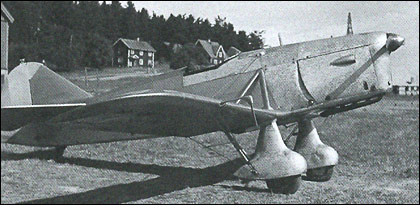| Andres Erdos, e-mail, 03.09.2012 05:04 Edmund Sparmann (1888-1951), mentioned on other pages in this website (Dront, Ö 4, J 1 etc) as he introduced the Austrian Phönix Aircraft in Sweden, established an aircraft factory in 1933 in Stockholm. Sparmann was born in Vienna and was an educated engineer. He had made several inventions in the aeronautical field, including an automatic stabilizer which was patented in several countries and which could be used in submarines and torpedoes as well as aircraft. During the WWI he served first in the Austrian Army flying corps and then became chief pilot and factory manager for Phönix-Werke in Vienna. His work also included designing military aircraft. Sparmann's first project was an "trainer fighter". He meant that such an aeroplane would provide a training in flying fighters that was as good as, but considerably cheaper than, training in a real fighter. The Air Board did not accept his reasoning and declined to buy the aeroplane. Sparmann built a prototype for his own means. The aeroplane got a civil registration (SE-ADX) in June of 1935, but crashed and was damaged beyond repair at an airshow the same summer. Finally in 1936 Sparmann got an order of four aircraft from the Air Force. Most of the order was to be paid by from the fund for combatting unemployment. This order was later followed by others. In total, Sparmann delivered ten of his "trainer fighters" to the Air Force. The Sparmann S-1 was a 1930s Swedish military training monoplane, designed by Edmund Sparmann, built in small numbers for the Swedish Air Force. The S-1 was a single-seat low-wing braced-monoplane with a fixed trail-skid landing gear. It was powered by a single 130 hp (97 kW) de Havilland Gipsy Major engine. The Air Force gave the type the designation P 1 (P = "Provflygplan"; in English "Trial Aircraft"). The maker's designation was S 1-A, but the aircraft was usually called "Sparmannjagaren" ("the Sparmann Fighter"). The ten P 1 got the Air Force numbers 811-820.
P 1 had a fuselage of steel tubes, covered by canvas. The wooden wings were covered by plywood. Control surfaces were covered by canvas and plywood. The aircraft had a wooden propeller. In wintertime, the P 1 could be equipped with skis. The aircraft was unarmed, but could be provided with a gun camera. Some P 1's were later modernized with a covered cabin.
Three P 1s was delivered to the Air Force Flight Academyl at Ljungbyhed, but remained there only for a few years. The P 1 served not very much in the intended role as "training fighter". As it had a long range, it was much used for liaison flying at various Air Force Wings around the country. The aircraft performed very well and was easy to fly. It was a popular "toy" among the pilots during the years of WWII. Only used by the Swedish Air Force.
General characteristics:
Crew: 1
Wingspan: 8 m (26 ft 3 in)
Powerplant: 1 × de Havilland Gipsy Major, 97 kW (130 hp) reply |










20
reply